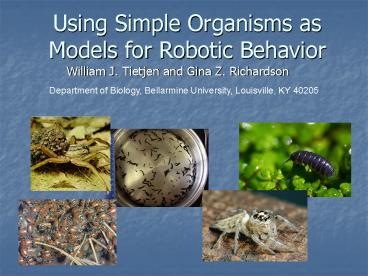Using Simple Organisms as Models for Robotic Behavior - PowerPoint PPT Presentation
1 / 10
Title: Using Simple Organisms as Models for Robotic Behavior
1
Using Simple Organisms as Models for Robotic
Behavior
- William J. Tietjen and Gina Z. Richardson
Department of Biology, Bellarmine University,
Louisville, KY 40205
2
Project Goals
- Use invertebrates animals as behavior models to
locate a diffuse stimulus. - Out gassing of methane.
- Rescue mission.
- Advantages of invertebrate models (spiders,
planarians, pill bugs). - Through evolution invertebrates solved complex
problems even though they have a limited number
of behaviors and often poor sensory systems. - Small brains Limited behavior
elegant solutions. - Small brains and limited behavior
reduction in processing and electrical power. - Small brains and limited behavior less
complicated programming model. - Program Aibo robots to mimic the animals
behavior. - Program Aibo robots to cooperate in an open agent
swarm. - Automate programming so animal models can be
quickly implemented to test multiple scenarios.
How does this differ from present models?
3
AIBO Programming System
The AIBO robot meets all the specifications for a
behavior-based programming environment (Arkin,
1998) including a hybrid deliberative/reactive
system, short- vs. long-term behavioral memory,
homeostasis, a variety of perceptual sensors, and
a capacity for communication. The AIBO
environment supports the deliberative
(goal-seeking) and reactive (reflexive) models.
In the deliberative mode the robot can be
programmed to seek a ball of a particular color,
follow a moving sound, and recognize and approach
another robot. Built-in routines that fulfill the
requirements of the reactive model include object
and precipice avoidance, power management, and
righting reflexes (if it falls over). Sensory
input is reacted to continuously and updated in
real time to allow adaptive responses in a
changing environment.
4
Tasks and Kinesis Models
- Goal 1 Locate a laser target using a taxis
model (similar to painting a target). - Goal 2 Locate a diffuse goal using a kinesis
model (visual gradient, but could be a methane
out-gassing). - Goal 3 Cooperate as an open agent swarm for the
same activities.
Taxis- A directed response to the
stimulus. Kinesis- Orientation without respect to
the direction of a stimulus. Orthokinesis- A
change in the rate of movement. Klinokinesis- A
change in the rate of turning.
5
Orthokinesis Model
High Humidity
Low Humidity
The top half of the container is a high humidity
environment. The Bottom is a low humidity
environment. Note that the animals stay in the
high humidity environment. (Original 1 frame/60
seconds)
One animal was placed in a moist habitat, the
other in a dry environment. Note the obvious
differences in their rate of movement. (Original
1 frame/5 sec)
6
Swarm Model
An open-agent robotic swarm where the
relationship among agents is fluid. Under the
conditions shown, Supervisor A has more precise
data concerning the location of the laser target
than does Supervisor B (determined by measuring
the diameter of the target in the robots field
of view). The Unaware Agent has its line of sight
blocked by an obstruction. Supervisor A therefore
becomes the temporary leader for this scenario.
The location can be transmitted by Supervisor A
to Supervisor B
and the Unaware Agent so they can efficiently
locate the laser target.
7
Organisms and Their Attributes
- Swarm 1 Uncooperative Group
- Swarm 2 Cooperative Group
- Vision 1 Simple Visual System
- Vision 2 Complex Visual System
- Taxis- A directed response to the stimulus
- Kinesis- Orientation without respect to the
direction of a stimulus.
8
General Recording Methods- Path Analysis
(Klinokinesis)
Fractal Analysis
Sony R Code
9
General Recording Methods- Behavior Analysis
Sony R Code
10
AIBO ERS-7 with Mind 3 Software- Operant
Conditioning





![Investigations on Automatic Behavior-based System Design [A Survey on] Hierarchical Reinforcement Learning PowerPoint PPT Presentation](https://s3.amazonaws.com/images.powershow.com/6219810.th0.jpg?_=20150306026)

























